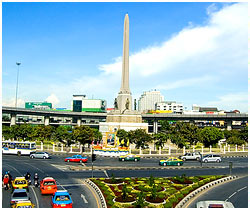It follows a westernized architectural pattern and stands in striking contrast to the nearby Democracy Monument, which incorporates Thai forms and symbols in its designs. The central obelisk, with its tall and tapering stance,
 clasps the five bayonets and is distinctively Egyptian
in style. Such monolithic structures are also seen in the various
military monuments of the West, where the obelisk is the metaphor of a
sword or the phallic symbol of masculine potency. Surrounding the base
of the five bayonets are carved statues, representing army, navy, air
force, police and civilians.
clasps the five bayonets and is distinctively Egyptian
in style. Such monolithic structures are also seen in the various
military monuments of the West, where the obelisk is the metaphor of a
sword or the phallic symbol of masculine potency. Surrounding the base
of the five bayonets are carved statues, representing army, navy, air
force, police and civilians.Designed by Italian sculptor Corrado Feroci, who later adopted the name Silpa Bhirasi, the bayonets have been shaped in typical western 'heroic' patterns, which were popular in fascist and communist states during the 1940's. There are bronze plates under these statues, impressed with the names of people who lost their lives during the war. Even though, in 1945, Thailand had to return all the territories it had gained in 1941, to France, and the monument lost the military significance of its erection, yet till date, it remains one of the most eye-catching landmarks of Bangkok.



